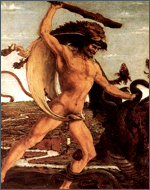

|
The Twelve Labours of Hercules
Tuesday, May 27, 2008 | Literature
The Twelve Labours (Greek: dodekathlos) of Herakles (Latin: Hercules) are a series of archaic episodes connected by a later continuous narrative, concerning a penance carried out by Herakles, the greatest of the Greek heroes. The individual confrontations of the hero with various animals reach back before Greek literacy, and to Oriental motifs: "It is open to question whether the early Greeks ever had the chance to see a live lion, but the migration of the lion image and the lion fight scene is well documented archaeologically," writes Walter Burkert (Burkert 1985, p 209), adducing as well the serpent with seven heads from Ugarit and the Old Testament. The establishment of a fixed cycle of twelve labours was attributed by the Greeks to an epic poem (now lost) written by a certain Peisandros of Rhodes, perhaps to be dated about 600 BCE (Burkert).
The traditional order of the labours is:
- Slay the Nemean Lion and bring back its skin.
- Slay the Lernaean Hydra.
- Capture the Ceryneian Hind.
- Capture the Erymanthian Boar.
- Clean the Augean stables in one day.
- Slay the Stymphalian Birds.
- Capture the Cretan Bull.
- Steal the Mares of Diomedes.
- Obtain the Girdle of Hippolyte.
- Obtain the Cows of Geryon.
- Steal the Apples of the Hesperides.
- Capture Cerberus.
Inner meaning
Behind their outer, literal meaning, Greek myths always hid an inner mystical tradition, and thus the labours could be interpreted as a symbolization of the spiritual path. This is particularly evident in an analysis of the eleventh, in which Hercules travels to the garden in which grows an apple tree with magical fruit, the tree of life, guarded by a dragon and a sisterhood—a parallel to the biblical legend of the garden of Eden where a serpent encourages the eating of the fruit from The Tree of Knowledge, granting the knowledge of good and evil. The last three labours (10-12) of Herakles are generally considered metaphors about death.

|


|

